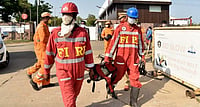The ongoing violence in Sudan against its civilians is "verging on pure evil". These were the words of the United Nations humanitarian coordinator for the country, Clementine Nkweta-Salami, earlier this month as the North African country is at risk of breaking apart. This has been the warning of experts as the war rages on for the seventh month with no end in sight. The conflict, which arose from unrest between leaders of two military groups -- the Sudanese Army and the paramilitary Rapid Support Forces (RSF) --- clashing for power is estimated to have killed over 10,000 people since April.
About 4.5 million have been internally displaced and a further 1.2 million have fled to neighbouring countries. Apart from the military havoc, the war has created unlivable conditions for civilians with them struggling to get their hands on basic supplies like food, water and medicine.
While one of the clashing parties, the RSF has control of the capital city of Khartoum and the western region of Darfur, the SAF has taken charge over the country’s north and east.
2003 Darfur War and subsequent conflicts
Sudan's history is marred by prolonged conflict and devastation. Although the current war began in April this year, decades of rebellions, violence, and suffering have plagued the region. Darfur, in particular, has been severely impacted and has suffered from genocidal violence for more than two decades.
In 2003, a rebellion broke out in Darfur when the economic condition of the region severely declined leaving civilians grappling with limited access to essentials like food, water, shelter, and medicine.
The western area had been largely neglected by the government with little to no representation in Sudan’s government.
The Sudan People’s Liberation Army/Movement (SPLA/M) and the Justice and Equality Movement (JEM) launched attacks on police stations and military bases in Darfur.
Huge protests broke out with civilians demanding economic justice and condemning the then president Omar Bashir for his authoritarian governance.
The country’s central army, SAF, was occupied in the south when the war stirred in Darfur. The president resorted to arming local Arab militias in the Darfur region known as Janjaweed to address the escalating situation.
There had always been tensions between Arab and non-Arab communities in Darfur for decades. And with Janjaweed now in charge of stopping the rebellion, the outcome was catastrophic
Janjaweed acted under Bashir’s directions and executed mass killings, poisoned wells, robbed, looted, raped, tortured, mutilated, burned villages, and wiped out entire populations.
About 3000 villages are estimated to have been completely destroyed. Roughly 300,000 were killed and 2.5 million displaced.
The United Nations operated a hybrid peacekeeping force in Darfur known as UNAMID (United Nations Assistance Mission in Darfur), consisting of 25,000 troops from the African Union and the UN. In 2020, UNAMID concluded its mission, asserting that the conflict had been resolved.
The Janjaweed leader, Mohamed Hamdan Dagalo, commonly known as Hemedti, earned Bashir's trust by successfully quelling the rebellion in Darfur. As a result, Bashir appointed him to a position in the central government.
Formation of RSF
Bashir formed another military group in 2013 in addition to SAF and gave them paramilitary status. The group was called Rapid Support Forces.
RSF’s tasks included maintaining internal security, combating rebel groups, and supporting the government's interests. The RSF played a significant role in conflicts in Darfur and was involved in suppressing protests against the government.
In 2017, a law legitimising the RSF as an independent security force was passed and the RSF was placed directly under Bashir. Bashir also granted the leader of the RSF access to certain gold mines in Darfur, aiming to foster a strong relationship and prove his loyalty
President Omar Bashir wanted RSF to be actively involved in the strengthening of the country, especially after the economic downturn which came as a result of losing several oil tanks to South Sudan when it gained independence in 2011.
In addition to its military responsibilities, the RSF engaged in activities such as smuggling weapons and minerals to neighbouring countries, and dispatching troops to conflict zones, all in exchange for financial gains. On the other hand, SAF had control over other industries like weapon production and telecommunications.
Even though the two military forces brought in funds to the country, the general population suffered and one of Sudan’s biggest protests broke out in 2018.
Despite severe crackdowns by the military forces, the rebellion persisted, refusing to die down. They demanded democracy.
When the protest continued for months, it became evident that the civilians wouldn't back down, the president was overthrown by the leaders of SAF and RSF themselves. The very men he trusted for his protection.
SAF leader Abdel Fattah Al-Burhan and RSF leader Mohamed Hamdan Dagalo joined forces to remove Bashir from power and stepped up to assume leadership in his place.
While civilians celebrated the removal of President Omar Bashir, their joy was tempered by the realisation that the men now in charge were the very figures responsible for decades of violence in the country
As calls for democracy grew louder, the RSF responded by executing individuals involved in protests. Massacres unfolded across the country, claiming the lives of several demonstrators.
When the situation worsened, several countries like the USA, UK, African Union, Ethiopia and several Arab countries intervened. They proposed the formation of a council consisting of members from the military groups and civilians, citing it as an opportunity to restore stability.
However, the power-sharing agreement between protestors and the military seemed to lean on one side with Burhan being appointed as chair and Hemedti as vice chair.
Abdalla Hamdok was appointed as president but he didn’t stay in power for too long. He resigned in January 2022 following interventions from the two military leaders. In his televised resignation Hamdok said: “Despite my efforts to achieve the necessary consensus to be able to deliver our people the promise of peace, justice and no bloodshed that did not happen.”
Upon his resignation, Burhan assumed the de facto leadership, with Hemedti as the second in command. However, discontent with the outcome led to a conflict between them, sparking a war for control.
What’s happening now?
As unrest ensued in the country, the two leaders were made to sign another agreement by the USA, UK, UAE and Saudi Arabia. Sudan’s coup leaders and the main pro-democracy group signed a deal Monday to establish a civilian-led transitional government.
However, the two leaders were not in agreement on a certain clause requiring RSF to become part of SAF’s army. Burhan wanted it done in two years, and Hemedti wanted it in ten.
These factors have fueled the ongoing conflict between them, with innocent civilians getting caught in the crossfire.


























